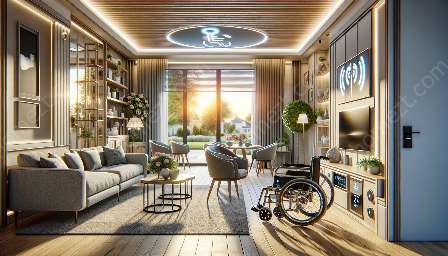Assisting the disabled and elderly individuals in smart homes requires thoughtful consideration and innovative solutions. In this topic cluster, we delve into the role of IoT devices in making homes more accessible and convenient for those with disabilities. Additionally, we discuss the significance of designing for disabled or elderly populations in smart homes and how intelligent home design can enhance their quality of life.
Understanding IoT Devices for Assisting the Disabled at Home
IoT devices, also known as smart devices, are revolutionizing the way individuals interact with their living spaces. These devices are equipped with connectivity features that allow them to communicate and exchange data over the internet. When it comes to assisting the disabled at home, IoT devices play a crucial role in providing support, enhancing safety, and improving overall living conditions.
Assistive IoT Devices
There is a wide range of IoT devices designed specifically to assist the disabled at home. These devices can be integrated into smart home systems to provide practical solutions for individuals with mobility, sensory, or cognitive impairments. For example, smart door locks with voice recognition capabilities can offer easier access for those with limited mobility. Similarly, smart thermostats and lighting systems can be controlled using voice commands, making them more accessible for individuals with physical disabilities.
Furthermore, IoT devices can also provide remote monitoring and alert systems to ensure the safety of disabled or elderly individuals. Motion sensors, fall detection devices, and emergency response systems are just a few examples of IoT technologies that contribute to creating a secure and supportive environment for those in need.
Enhancing Independence and Accessibility
By harnessing the power of IoT, disabled individuals can experience greater independence and autonomy within their homes. Smart assistive devices can automate routine tasks, such as adjusting room temperatures, turning on lights, or even reminding individuals to take medication. These innovations empower disabled individuals to manage everyday activities more efficiently, thereby promoting a sense of freedom and self-sufficiency.
Moreover, IoT devices can be integrated with smart home accessibility features to create barrier-free environments. From voice-controlled home automation systems to IoT-enabled wheelchair ramps and door openers, these technologies contribute to making homes more inclusive and accommodating for individuals with disabilities.
Designing for Disabled or Elderly in Smart Homes
When considering intelligent home design, it is imperative to prioritize the needs and challenges faced by the disabled and elderly populations. Designing for disabled or elderly individuals in smart homes involves creating spaces that are inherently accessible, safe, and conducive to independent living.
Universal Design Principles
Universal design principles emphasize the creation of environments that are usable by people of all abilities, ages, and backgrounds. In the context of smart homes, these principles guide architects, designers, and technologists to develop inclusive spaces that can accommodate diverse needs and preferences. Incorporating features such as wider doorways, lever-style door handles, and adjustable-height countertops aligns with the universal design ethos, enabling greater accessibility for disabled and elderly occupants.
Technological Integration
Integrating IoT devices into the design of smart homes offers immense potential for enhancing the quality of life for disabled and elderly individuals. Home automation systems, voice-activated controls, and assistive technologies can be seamlessly incorporated to create homes that cater to the unique requirements of these specific populations. Through careful planning and collaboration with accessible technology experts, intelligent home designs can leverage IoT solutions to promote convenience, comfort, and independence for the disabled and elderly.
Intelligent Home Design and Its Impact
The concept of intelligent home design revolves around creating living spaces that are adaptive, responsive, and efficient. By integrating IoT devices and smart technologies, intelligent home design strives to improve the overall well-being of occupants, including disabled and elderly individuals.
Smart Environments for Enhanced Living
Intelligent home design encompasses the implementation of interconnected systems and devices that contribute to a more cohesive and seamless living experience. For disabled or elderly occupants, this means having access to intuitive interfaces, personalized settings, and automated functionalities that cater to their specific needs. By leveraging IoT devices, homes can be transformed into intelligent environments that support independent living while prioritizing safety and comfort.
Personalized Healthcare Solutions
IoT devices in smart homes have the potential to revolutionize healthcare management for disabled and elderly individuals. From remote health monitoring to medication management systems, intelligent home designs can integrate IoT technologies to offer personalized healthcare solutions. These solutions not only alleviate the burden of managing medical needs but also contribute to early detection of health issues and timely intervention, promoting better overall health outcomes.
Conclusion
The integration of IoT devices in the context of assisting the disabled at home, designing for disabled or elderly in smart homes, and intelligent home design represents a significant step towards creating more inclusive and accommodating living environments. Through innovative solutions, thoughtful design considerations, and a focus on personalized experiences, smart homes can be transformed into empowering spaces that elevate the quality of life for disabled and elderly individuals.


